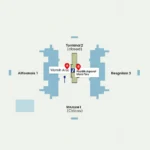The term “1d Airport” often sparks curiosity among travelers. While not a universal term, it typically refers to a specific section or area within an airport terminal, designated as “1D”. This guide delves into understanding airport layouts, deciphering terminal sections like “1D,” and navigating them effectively for a smoother travel experience.
Understanding Airport Layouts
Airports, especially large international ones, are intricate complexes designed for efficient passenger flow. They are commonly structured with one or more terminals, further divided into concourses, gates, and other designated areas.
Terminals are like individual buildings within the airport, often assigned to specific airlines or groups of airlines. For instance, Terminal 1 might handle domestic flights, while Terminal 2 caters to international travel.
Within each terminal, you’ll find concourses, which branch out like arms from a central point. Concourses house gates, where passengers board and disembark aircraft.
 Airport terminal layout illustration
Airport terminal layout illustration
Deciphering “1D” within an Airport Context
“1D” typically signifies a specific zone or section within a larger area, most likely a terminal, at an airport. This alphanumeric system helps organize the airport and guide passengers.
Here’s a likely breakdown:
- 1: Refers to Terminal 1 within the airport.
- D: Indicates a specific section within Terminal 1, possibly a concourse or a designated area within a concourse.
Airports employ varied naming conventions; therefore, the exact meaning of “1D” can differ. Always refer to the airport’s official website or signage for clarification.
Navigating to Your 1D Gate
Imagine arriving at an unfamiliar airport with a boarding pass indicating “Gate 1D-22.” This means your departure gate (22) is located in section “D” of Terminal 1. Here’s how to navigate:
-
Check Airport Monitors: Upon arrival, consult the flight information display screens for your flight details and confirm the assigned terminal and gate.
-
Follow Airport Signage: Airports prominently display directional signs. Look for signs guiding you toward Terminal 1.
-
Locate Section “D”: Once inside Terminal 1, search for signs directing you to section “D,” your designated area within the terminal.
-
Find Your Gate: Finally, follow the numerical sequence of gates to find Gate 22 within section “D.”
 Passenger following airport signage
Passenger following airport signage
Tips for Smooth Navigation
-
Arrive Early: Allocate ample time for navigating unfamiliar airports, especially during peak hours.
-
Utilize Airport Maps: Many airports provide maps on their websites or within the terminal. Familiarize yourself with the layout beforehand.
-
Don’t Hesitate to Ask: Airport staff are stationed throughout terminals to assist passengers. Don’t hesitate to ask for directions or clarification.
Importance of Understanding Airport Layouts
A clear understanding of airport layouts, including the significance of designations like “1D,” contributes to a less stressful and more efficient travel experience. It empowers travelers to navigate confidently, reach their gates on time, and embark on their journeys with ease.
FAQs:
What if I can’t find my gate?
Don’t panic! Locate an airport staff member or information desk. They can guide you to your correct gate.
Can the meaning of “1D” vary between airports?
Yes, airport naming conventions can differ. Always double-check with the specific airport’s website or signage.
Need Further Assistance?
For any travel-related queries or assistance with your journey, our dedicated customer support team is available 24/7. Reach us at +13089626264, email us at [email protected], or visit our office at 404 Bothwell St, Oxford, NE 68967, USA. We’re here to help!

